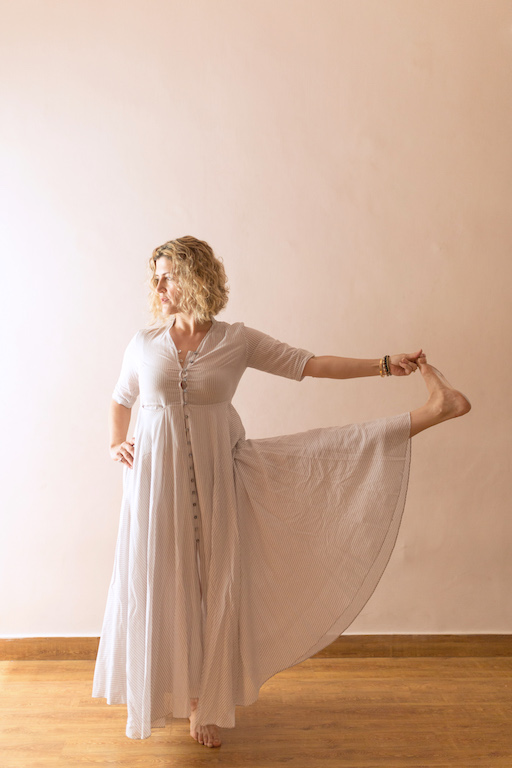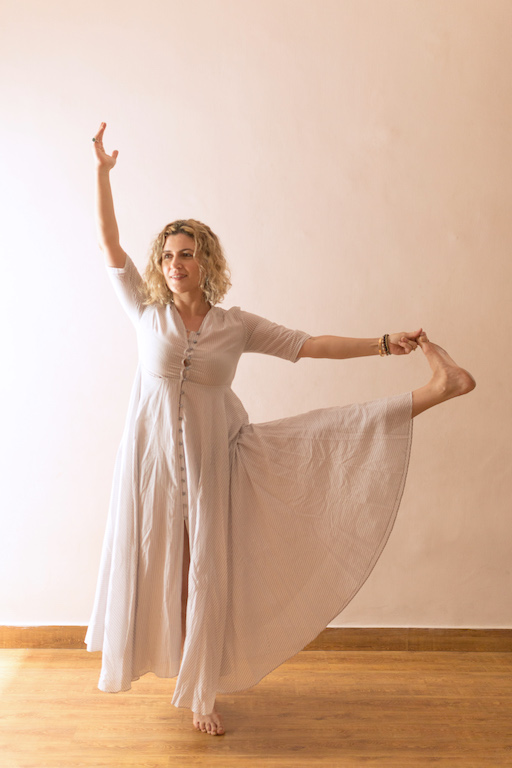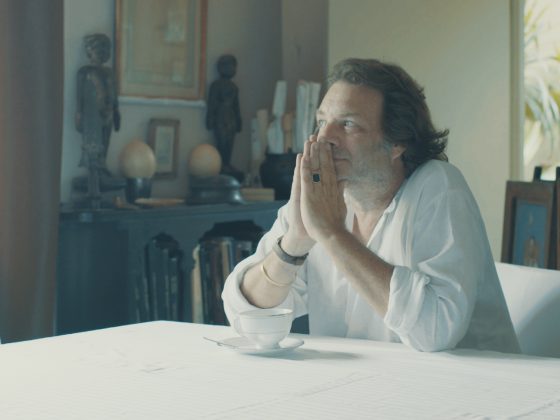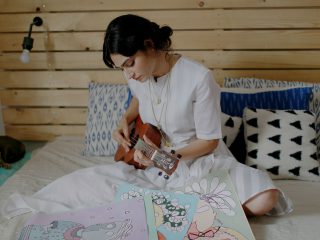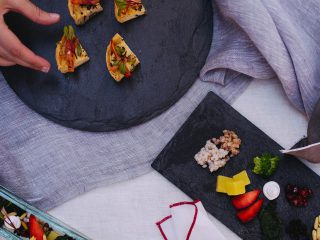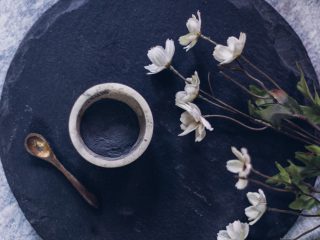Tucked into Delhi’s Hauz Khas you’ll find the Seema Sondhi yoga studio. A homey place, with a devoted following, there’s nothing quite like it in the capital. You’ll find a pick-and-mix of styles dotted across the morning and evening, Monday to Sunday. There’s ashtanga, both led and Mysore-style, there’s vinyasa flow classes, both beginner and intermediate level, and there’s yin yoga.
They don’t list the teachers on their class schedule, but we met their core trio of teachers – Seema, her sister Bindiya, and Anuska, from Delhi, Hyderabad, and Bosnia respectively. Seema is whip-sharp; attentive and with keen eyes. She found yoga after three lumbar slip discs and one surgery. Six months of training at home with a teacher later she hung up the spinal belt and started on her path to becoming a certified teacher, doing for her students what that teacher did for her. 23 years later she is still a student (she says), and her path is now, as it always was, a growing, humbling journey.
“I wanted to spread the message of yoga so I decided to open up a studio. It was also fulfilling to begin a business and turn from a housewife to a businesswoman.”
The warrior with Seema Sondhi
Tell us about the yoga at the studio.
We have a mix of classes, such as yin, prenatal, vinyasa flow and ashtanga primary series. It’s a good mix of classes to suit beginners to advanced students. It does become very confusing for people to understand the differences with all the fancy names, but yoga is the same everywhere, it’s just how you sequence the asanas and modify them to make it harder or easier.
Vinyasa is just like a chorus to a song, it’s a repeated set of movements so we use the vinyasa to stitch together the asanas so we have a complete song! Yin yoga is focused on working the deeper muscles of the body and holding of the asanas; the ashtanga primary series is a set of fixed poses which is taught the same the world over.I do more of a flow in all of our classes where we go from one asana to another with an added vinyasa. To help explain it a bit better, an asana is a fixed pose – Downward Dog, Plank, Cobra etc. I usually take the ashtanga vinyasa, yin classes along with the moon sequence at the studio.
“Vinyasa is just like a chorus to a song, it’s a repeated set of movements so we use the vinyasa to stitch together the asanas so we have a complete song!”
Talk to us about the distinction between practicing yoga in a group class or community versus practicing solo – do you recommend beginners start out in group classes and then progress into a solo practice?
It is definitely much better to start with a group. It is very confusing when you first start out and with a group you can see what the other person is doing and join in, lots of my students have made great connections with other students during classes, we go for coffee, dinner and retreats together. In today’s world, at least it will make you look away from your phones to say hi to the student next to you, it’s a place to share, learn and bond! I have made such good friends from all over the world through the studio, it is amazing how many people I have met through yoga and I am always excited to meet them when they visit or when I visit their part of the world. Solo sessions are good for people suffering from ailments, those who want to work on certain aspects of their practise and want to deepen their understanding of yoga.
Online tutorials or in-person guidance?
Of course I would recommend finding a good teacher but if that’s not possible online is a very good way to start your journey into yoga.
How does food factor into a yogic lifestyle?
If you’re doing yoga correctly you will feel that clarity and consciousness in your mind to make correct food choices. You have to eat right to complement any workout, drink plenty of water but do indulge occasionally!
Is it ever too early or too late to start?
Yoga is one for all. It can be modified for everyone, be it seniors, children, diabetic patients… I have lots of prenatal students who come for sessions after they’ve delivered; they bring their babies along for classes and it is quite nice to see that bond with them over yoga! It’s never too late to start anything and never too early to begin your practice.

Do you have a favourite pose or sequence?
The wide angle forward bend.
Can you tell us about your own personal rituals?
I get up at 6am to meditate, it’s a time I spend with myself and my dog Zoey who takes over my mat before anyone’s awake. I have cut off artificial sugar from my diet completely which is doing wonders for my mind and body. My beauty regime is very rigorous and I take time in the morning and nights to take care of my skin and I use lots of natural solutions to help keep my skin healthy.
You’re certified to teach the moon sequence or Chandra Karma. For the uninitiated, what sets this sequence apart from others in yoga? Why did you take to it?
The moon sequence is developed by my teacher Matthew Sweeney, it’s to be essential for all ashtanga practitioners, men and women. This sequence will help you rebalance energetically, psychologically and physically. In particular, as over 80 percent of ashtangis are women, the need for a sequence that is focused on menstruation, ovulation and the phases of the moon is absolutely necessary. The Moon Sequence is intended to help awareness of the cycles of the Moon and encourage your intuitive faculty. It is not intended to entirely replace your ashtanga practice, or any other practice for that matter, rather to enhance and balance your weekly routine.

The crow with Bindiya
Tell us about your journey into yoga.
Yoga just happened to me. I used to live in Hyderabad and in the summer used to come Delhi and practice yoga with my sister, Seema. In the summer of 2006, Seema insisted I do the teachers training course. My kids were 12 and 16 then, old enough to leave them with my ex-husband. Not without a few arguments I came to Delhi a week later and did a month-long course. Since then, I have been studying and practicing yoga. I’ve been teaching since 2009.
What kind of yoga do you teach at the studio?
I teach a vinyasa krama which incorporates asana, pranayama and a little bit of meditation.

How does yoga figure into your day?
For me to start my day with a strong individual personal practice is very important. Through my asana practice I’m able to energise my entire day, with pranayama I get clarity to teach 4-5 classes in a day. With meditation, I get focus to pursue my ultimate goal. Through yoga I’m able to balance and bring peace.
Talk to us about the distinction between practicing yoga in a group class or community versus practicing solo.
I think beginners should start either in a beginners class or solo to understand their bodies, mind and breath, then advance to group classes. In a community class one can get consumed by watching others who’re better, more flexible than them – often trying to achieve a pose, for which their bodies are not ready. And above all each individual is different, unique and special. They need a class which is structured to their needs and goals. Once an individual understands themselves better, no matter where they practice they will not get distracted by others and be responsible for themselves. In the end, yoga is about understanding yourself – going out and helping build a better, stronger community. If one is consumed by comparisons, ego, pride and prejudice where is the contribution in building a better community?

How does food factor into a yogic lifestyle?
According to Ayurveda, one needs to eat according to their Prakriti (individual constitution) – pita, vata and kapha. One should include a balance diet of all tastes – sweet, sour, salty, bitter, pungent and astringent. Eat according to seasons: freshly cooked food. There are some foods like ghee, pomegranate, grapes etc. which are nityahara and should be eaten daily. There is no point in following fads, diets and theories when your body is not equipped to handle them.
“According to Ayurveda, one needs to eat according to their Prakriti (individual constitution) – pita, vata and kapha. One should include a balance diet of all tastes – sweet, sour, salty, bitter, pungent and astringent. Eat according to seasons: freshly cooked food.”
Is it ever too early or too late to start?
Yoga suits everyone. It’s never too late to start. You should start as early as when a child says they are hungry and they able to eat on their own and keep practicing till the end.
Do you have a favourite pose or sequence?
I do not have a favourite sequence as I design my own structure according to what my goal is. The headstand is one of my favourite poses.
The standing leg raise with Anuska
Why yoga?
Coming from a very different culture, I have been active my whole my life. Was invested in a lot of sports, but did not know ‘where to put my mind’. So finally yoga happened! I have been practising for 8-9 years now.
What kind of yoga do you teach at the studio?
Vinyasa classes, prenatal classes and yin yoga. I do teach private sessions as well, where some energetic students in need of one-on-one bandwidth or simply for restorative practices come by.
How does yoga figure into your day?
Living in Delhi is lovely, but it can get challenging. Over a period of time I’ve learned to preserve my energy, be more mindful and try my best to be patient. I am grateful I have yoga to guide me.
Talk to us about the distinction between practicing yoga in a group class or community versus practicing solo.
It all depends on the students. For some you’re thinking: “this person needs group energy to get motivated” and other times: “this person could use some one-on-one time.”
Online tutorials or in-person guidance?
Let’s stick to tradition, the way lineage has been carried: from teacher to student. Later on, students can move on and do self-practice.
How does food factor into a yogic lifestyle?
Digestion takes so much energy, why make it more difficult? I’m a vegetarian, but I don’t believe you should be ‘this’ or ‘that’. Just observing one’s energy levels, the way certain foods affect their bodies and how to go about it. I believe in local ingredients and helping this planet by eating locally-grown produce. With age we change; our diets should alter accordingly.
Is it ever too early or too late to start?
It’s never too early, never too late. That said, children below the age of 7 should be supervised as their spines are not fully developed. A sequence for a 70-year-old would have to be altered accordingly, but not all 70 years-olds are the same either. I often see students who’re devout and age is not a barrier for them, they use the wisdom acquired over time to alter poses, the usage of props and by extension are never out of place in our studio.

Favourite sequence or pose?
Whatever feels right at the moment; sometimes it’s the moon sequence, sometimes it’s a hip opening sequence. Depends on how I feel.
Can you tell us about your own personal rituals?
My day should have PYC = Prayers+Yoga+Coffee and I am good to-go.
You’re originally from Bosnia. Do you ever plan to teach there?
‘Ever’ is a strong word. As of ‘now’ Europe is not so attractive for me. My heart’s with the East. My Guru ji is here, and I’ve been so grateful for all the knowledge and love she’s showered me with.



